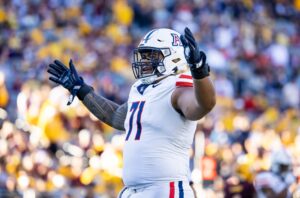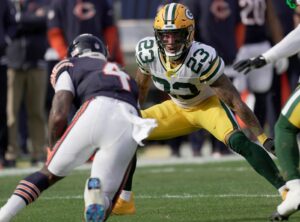Another NFL Draft is in the books. After seven rounds and 253 picks, all 32 teams now officially have their incoming class of prospects. Of course, the biggest question fans have in the aftermath of the draft is how well their favorite team did in terms of addressing their biggest positional needs.
Now it must be said that it’s difficult to give a fully accurate evaluation this early in the process. The true measure of whether or not a given draft class was hit or miss won’t be evident until these players have been on the field for a few years. But that doesn’t mean we can’t do some immediate post-draft prognostication.
Which teams aced the 2017 NFL Draft? Which ones left fans and experts scratching their heads? And which ones fell in between those two extremes? All of it will be addressed in our draft grades. Here, the focus is on the AFC South and AFC West.
Last Word On Pro Football 2017 NFL Draft Grades: AFC Part Two
Houston Texans: B+
Picks
1 (12): Deshaun Watson, quarterback, Clemson
2 (57): Zach Cunningham, linebacker, Vanderbilt
3 (89): D’Onta Foreman, running back, Texas
4 (130): Julie’n Davenport, offensive tackle, Bucknell
4 (142): Carlos Watkins, interior defensive lineman, Clemson
5 (169): Treston Decoud, safety, Oregon State
7 (243): Kyle Fuller, center, Baylor
Of the prominent quarterback prospects in this draft, Deshaun Watson is the only one who proved himself a consistent winner in college. Couple that with the fact he has a head coach known for getting the most out of his quarterbacks (well, with the exception of Brock Osweiler) and you have the next potential star in the making. Don’t be surprised if Watson is thrust into the spotlight early if Tom Savage struggles.
Watson’s collegiate teammate Watkins could’ve gone earlier than he did and adds depth to a defensive front ravaged by injuries last year. In Foreman, Houston is getting a hard-working, high character individual whose ceiling is high if he can take care of the football better. The team tried to address their needs on the offensive line, but essentially rolled the dice with developmental projects.
If Watson pans out, both the Texans and the league as a whole will look back on this draft in a very positive light.
Indianapolis Colts: A-
Picks
1 (15): Malik Hooker, safety, Ohio State
2 (46): Quincy Wilson, cornerback, Florida
3 (80): Tarell Basham, edge rusher, Ohio
4 (137): Zach Banner, offensive tackle, USC
4 (143): Marlon Mack, running back, South Florida
4 (144): Grover Stewart, interior defensive lineman, Albany State (GA)
5 (158): Nate Harrison, cornerback, Temple
5 (161): Anthony Walker, linebacker, Northwestern
Hooker fell into the Colts lap at 15 after concerns over his recent surgeries caused him to fall a bit. Though he’ll need to improve as a tackler and lacks experience, he’s about as good of a “centerfielder” kind of safety in this draft. His upside as a big-time playmaker is immense and he should see plenty reps early on.
Similar to Hooker, Wilson needs to work on his ability to bring runners down. But he’s a confident competitor who should blossom into a fierce press corner in time. He’s joined at the position by Harrison who played wide receiver in college but will move to the other side of the ball as a pro. Both players’ ball skills will be welcome on a unit that ranked bottom quarter of the NFL in interceptions last year.
Indy added a single offensive lineman in tackle Zach Banner. At 6’8″ and 353 pounds, he’s among the bigger prospects in this draft class. But it remains to be seen whether or not the unit as a whole can consistently protect Andrew Luck so that the prime years of his career aren’t squandered.
Overall, the Colts addressed most of their key needs fairly well. Watch out for Marlon Mack. He’s a potential stud in the making.
Jacksonville Jaguars: C+
Picks
1 (4): Leonard Fournette, running back, LSU
2 (34): Cam Robinson, offensive tackle, Alabama
3 (68): Dawuane Smoot, edge rusher, Illinois
4 (110): Dede Westbrook, wide receiver, Oklahoma
4 (148): Blair Brown, linebacker, Ohio
7 (222): Jalen Myrick, cornerback, Minnesota
7 (240): Marquez Williams, fullback, Miami (OH)
Running back wasn’t exactly a glaring need for the Jaguars. But a talent like Leonard Fournette is simply too good to pass up. Fournette is a multi-year All-Pro in the making and could be this year’s Ezekiel Elliott. Clearly, the Jags played their “best available” hand in drafting the talent out of LSU.
Jacksonville also gave their offensive line a noticeable upgrade with their selection of Robinson in the second round. The left tackle out of Alabama had a first round grade by most scouts but likely fell due to off-field concerns. A player with a similar situation from a character standpoint is Westbrook, who was a Heisman Trophy finalist last year. His upside is as high as any wideout in this year’s draft if he can stay out of trouble.
The flaws in this incoming crop of prospects is the dearth of offensive linemen. Jacksonville had needs up and down that unit. But this draft is abnormally short of talent on the O-line which probably precluded the Jags from addressing the needs fully. And they’re still short a replacement for Julius Thomas at tight end.
Tennessee Titans: A-
Picks
1 (5): Corey Davis, wide receiver, Western Michigan
1 (18): Adoree’ Jackson, cornerback, USC
3 (72): Taywan Taylor, wide receiver, Western Kentucky
3 (100): Jonnu Smith, tight end, Florida International
5 (155): Jayon Brown, linebacker, UCLA
6 (217): Corey Levin, offensive lineman, Chattanooga
7 (227): Josh Carraway, linebacker, TCU
7 (236): Brad Seaton, offensive tackle, Villanova
7 (241): Khalfani Muhammad, running back, California
Marcus Mariota needs more targets to throw to. And Titans general manager Jon Robinson answered his wishes with this draft class. Corey Davis went a lot earlier than expected, especially considering teams couldn’t even evaluate him at the Combine or his Pro Day due to an ankle injury. But his collegiate production, body type and skill set proved too good to pass up for Tennessee.
In Taylor, Mariota’s getting a player he can utilize in the short, intermediate and deep routes. He’s dynamic after the catch and a surefire threat in the vertical passing game. Smith’s tape doesn’t jump off the screen but he’s a reliable, no nonsense tight end that could be a viable replacement for an aging Delanie Walker.
And what’s not to like about Adoree’ Jackson. He’s basically a poor man’s Jabrill Peppers. Or is it the other way around? Either way, Jackson’s playmaking ability in the secondary should help a defense that ranked 29th against the past last year. Combine that with his special teams prowess and he’ll see reps early and often for the Titans.
In a wide open AFC South, Tennessee is primed to break through and compete for the division.
Denver Broncos: B+
Picks
1 (20): Garett Bolles, offensive tackle, Utah
2 (51): DeMarcus Walker, edge rusher, Florida State
3 (82): Carlos Henderson, wide receiver, Louisiana Tech
3 (101): Brendan Langley, cornerback, Lamar
5 (145): Jake Butt, tight end, Michigan
5 (172): Isaiah McKenzie, wide receiver, Georgia
6 (203): DeAngelo Henderson, running back, Coastal Carolina
7 (253): Chad Kelly, quarterback, Ole Miss
It’s not often that a seventh round pick generates the amount of buzz Denver’s selection of Chad Kelly garnered. But that’s what happens when a quarterback with middle round talent at the very least gets drafted as “Mr. Irrelevant.” Kelly’s injury history and off-field concerns precipitated his fall but, hey, at least he didn’t go undrafted.
Further up the order, the Broncos needed a left tackle after Russell Okung departed via free agency. Garett Bolles might be the best in this class and was the first offensive lineman off the board as a result. As good as he is, he still hasn’t reached the high end of what he’s capable of, which is a scary though.
Jake Butt fell due to an ACL tear suffered in the Orange Bowl but he’s a reliable and versatile tight end with starting potential when fully healthy. Henderson and McKenzie add depth to the receiving corps with the latter a potential answer to revive a dormant special teams unit on punt returns.
And in Walker, Denver is getting a potential beast as a five-technique defensive lineman in their 3-4 scheme. Overall, this haul of draft picks addresses the Broncos positional needs relatively well.
Kansas City Chiefs: B-
Picks
1 (10): Patrick Mahomes, quarterback, Texas Tech
2 (59): Tanoh Kpassagnon, edge rusher, Villanova
3 (86): Kareem Hunt, running back, Toledo
4 (139): Jehu Chesson, wide receiver, Michigan
5 (183): Ukeme Eligwe, linebacker, Georgia Southern
6 (218): Leon McQuay III, safety, USC
The Chiefs made the biggest move of the draft in trading up to the tenth spot and picking Mahomes. Though the Texas Tech product has a cannon for an arm, his learning curve will be steep in trying to grasp Andy Reid‘s offense coming from an “Air Raid” system. That system puts up gaudy numbers in college but is very vanilla when compared to a pro-style playbook. Still, his skill set suggests a high ceiling player.
At 6’7″ and 289 pounds, Kpassagnon is a physical specimen. His 35 5/8″ inch arms add further to his freakish frame. He has the tools to be an effective pass rusher at the next level but is still a work in progress in terms of unlocking his full potential.
Hunt’s instincts as well as his downfield vision are off the charts. And he once rushed for five touchdowns in a bowl game which is tied for the most in FBS history with Barry Sanders. It may not be long before the running back out of Toledo is figuring prominently into the Chiefs ground game.
In summary, the concerns over Mahomes readiness plays a part in dragging down this grade a bit.
Los Angeles Chargers: A-
1 (7): Mike Williams, wide receiver, Clemson
2 (38): Forrest Lamp, offensive guard, Western Kentucky
3 (71): Dan Feeney, offensive guard, Indiana
4 (113): Rayshawn Jenkins, safety, Miami
5 (151): Desmond King, safety, Iowa
6 (190): Sam Tevi, offensive tackle, Utah
7 (225): Isaac Rochell, interior defensive lineman, Notre Dame
The Chargers have finished in the bottom half of the league in sacks allowed during the past three seasons. So making sure Philip Rivers is hit less was a high priority in this year’s draft. It showed with the selections of Lamp and Feeney. Lamp took on Alabama’s pass rushers last year and excelled. And Feeney possesses a mean streak and helped create holes for current Chicago Bears running back Jordan Howard while at Indiana.
Williams gives Rivers a big-bodied physical presence who will dominate in the red zone. The veteran quarterback will love finding him on back shoulder throws. The pass catcher out of Clemson should have an immediate impact in the Chargers pass game.
Tevi is an intriguing late round add that further bolsters the offensive line. He’s part of a surprisingly large number of players drafted out of Utah. All in all, eight Ute prospects had their name called during the three days of the draft.
Kudos to the Chargers for bringing in one of the more impressive hauls of this year’s draft from a team needs standpoint.
Oakland Raiders: B
1 (24): Gareon Conley, cornerback, Ohio State
2 (56): Obi Melifonwu, safety, Connecticut
3 (88): Eddie Vanderdoes, interior defensive lineman, UCLA
4 (129): David Sharpe, offensive tackle, Florida
5 (168): Marquel Lee, linebacker, Wake Forest
7 (221): Shalom Luani, safety, Washington State
7 (231): Jylan Ware, offensive tackle, Alabama State
7 (242): Elijah Hood, running back, North Carolina
7 (244): Treyvon Hester, interior defensive lineman, Toledo
Oakland had a multitude of needs on the defensive side of the football. They addressed them fairly well in the first three rounds of the draft in selecting Conley, Melifonwu and Vanderdoes. Conley was in the news for all the wrong reasons ahead of the draft after being accused of rape. But he reportedly passed a polygraph test which gave the Raiders a green light to take him in the first round.
Off-field trouble aside, Conley is as good as it gets in this cornerback class. He’s phenomenal in press man and can also win in zone situations. He has the length to be a lockdown presence vertically. Though physical receivers can throw him off, he has all the makings of an instant impact player in the Raiders secondary.
Much of the post draft discussion surrounding Melifonwu primarily surrounded his role in neutralizing athletic tight ends down the middle of the field. It centered around a potential AFC playoff matchup between the upstart Raiders and the defending Super Bowl champion Patriots. Can you imagine a player of Melifonwu’s length and overall athleticism matched up against Rob Gronkowski? It’s a mouth-watering prospect indeed.
The one thing missing from this class is a playmaking tight end. Though they added Jared Cook in free agency, he’s far from a game changer considering he’s managed just four receiving touchdowns over the past three seasons. Considering the depth of this crop of tight ends, it would’ve been nice for the Raiders to take advantage.
But overall, Reggie McKenzie continued to work his magic in turning the Silver and Black into a championship contender.
AFC East and AFC North
NFC East and NFC North
NFC South and NFC West






